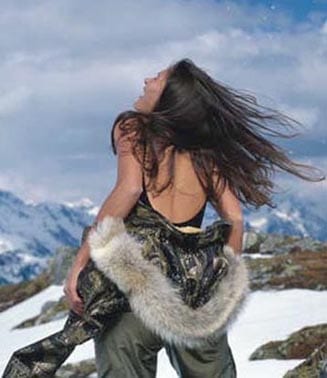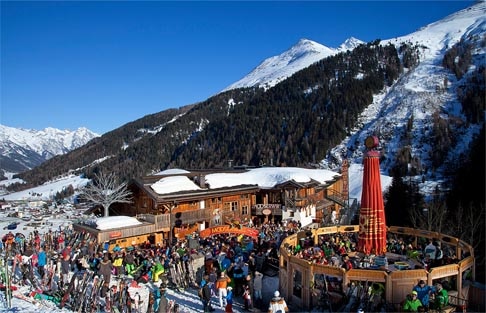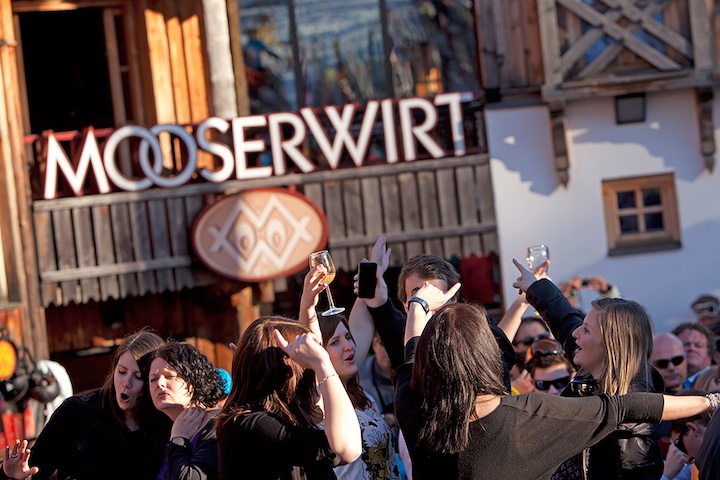Skiing To Ski Apres And The Famous ‘Mooserwirt Syndrome’ Bar

Just like merging trails, the mountain and the nightlife of St. Anton in the Austrian Alps come together to form a perfect run for the Ski Apres-minded sloper.
Ideal snow conditions, a challenging mountain and something known locally as the “Mooserwirt Syndrome” combine to make this one of Europe’s top winter playgrounds, the Mykonos of March (and other snow months).
Located an hour from Innsbruck, St. Anton gets people from all over the continent, as well as a sprinkling from places throughout the world.
A frequent host of the World Alpine Championships, St. Anton is a slopeside ski village at the foot of the Alberg pass. Upon arrival, the first impression is likely to be, “Wow, this really looks like a postcard Austrian ski village.” Then you realize that oh, this really IS a postcard Austrian ski village.
The town itself is mostly bars, hotels and sports shops. Those seeking upscale shopping will be better served 20 minutes away at upscale Lech. In St. Anton, people don’t go exclusively for the partying but, in the words of one local, it is “great added value after the skiing.”
The nearest airports are Innsbruck (about 100 kilometers away), Munich ( 200 kilometers) and Zurich (also about 200 kilometers). Munich and Zurich have rail service and Zurich has a weekend bus; all have rental cars. From the train or bus there’s a Eurocity Station located in the middle of the village.
Train travelers will find St. Anton a convenient destination, with the train station located centrally in the village. All international service stops here, including the famed Orient Express. It’s just one of 15 international trains that stop here.
Accommodations in availble in town and it’s recommended to book in advance.
St. Anton: The Mountain
Resort base: 1,304 meters/4,278 feet
Base of ski lifts: 1,304 meters/4,278 feet
Top of the lifts: 2,811 meters/9,222 feet
Mountain Top:Ê 2,804 meters/9,200 feet (Valluga)
Vertical Drop:Ê 1,501 meters/4,930 feet
Lift Tickets: 42.50, 81, 117 Euros euros, useable at most skiing centers in the vicinity.

This also includes free shuttle bus use to and from ski areas. The Arlberg Ski Pass for instance, covers the resorts of St. Anton, St. Christoph, Stuben, Lech, and Zurs. This pass offers an astounding 92 lifts with access to the major trail-runs at St. Anton, Stuben, Klšsterle, Lech, and ZŸrs.
St. Anton has vast terrain, almost enough to keep skiers and boarders busy for a week and it has a reputation for having a consistent abundance of snow. In fact, it often has the deepest snow base in the Alps. Mostly comprised of intermediate runs, the mountain also has some steep challenges for experts.
Be careful of going over a mountain crest – you may wind up in at completely different resort in a different town. If there’s an opening at the ski lift, go for it. The fine British custom of queuing up is as distant as, well, Britian. There are no singles lines, no corrals, just a rush to be first to the chair.
St. Anton and Arlberg has 92 lifts consisting of eight trams, 12 chairs and 72 surface lifts. Nearby Valluga (9,222 feet / 2,811 meters) is best for Advance skiers but altitude sickness is not uncommon and the terrain can be tricky for those not familiar with the area. The best part is the Galzig and Valluga cable cars found at the edge of the village, both providing spectacular scenery.
St. Anton Ski Apres – Nightlife and Bars


The true test of a strong ski/party resort is its post-slopes bar. Here, St. Anton reaches a high peak. And the party literally goes from sunset to sunrise.
At the top of the list is the Mooserwirt Bar. It packs in hundreds of skiers and snowboarders, drinking beer and schnapps while a DJ plays euro remixes and dance tunes. It’s located a few hundred feet from town off the main run. After a while, it’s slopes be damned and next thing they know, people find it’s too challenging to rise the next morning to ski.
But getting back to the Mooserwit by afternoon is a breeze. Thus, the Mooserwit Syndrome. Some even warm up to Mooserwit by first visiting Griblies, which has a great British band.
Fortunately, the fun doesn’t stop at the Mooserwit. The Krazy Kangaroo Bar, located on the mountainside above the resort, also packs in the people. It has loud rock and hip-hop music. It’s popular for those who want to see the sun go down, along withT.A.P.S.
After the KK or Mooserwit, it’s a quick ski/slide down to town. There’s leftover Apres at Picca or Scottys, but be back at Scotty’s by 9. From there, it’s like being back on the slopes deciding on what trail to take there are so many choices. Like the mountain, there’s a week’s worth of options.
There’s Underground, Drop In and Amadeus, the latter of which has happening tunes, very popular among the Scandinavian skiers and snowboarders. Alibi, a well-named bar for missing the ski lesson the next day, is a good bar with good music.
Extreme Shredders hang at Postkeller, Piccadilly and The Funky Chicken. The Piccadilly is the best place to hear live music. And in the village, you’ll find the Picca, Scotty’s, or the Underground. In the early morning you might want to check out a fantastic mountain sunrise at the Kartouche club.
Those definitely not intending to ski the next day head to Bar Cuba, which has strong drinks, loud music and an eye-pleasing staff. This is a late-night bar. Fore really late nights – all-nighters, really – catch the sunrise at Kartouche.
A good Friday night call is Hazienda, a non-Alpine decorated bar and restaurant popular for people from Munich and other nearby cities zooming into town for the weekend.
Drinks and entrance fees are between 4-6 euros and usually include a first drink with the door cover. Some of the more sophisticated bars in town are The Platzl’s AprŽs and St. Antoner Hof’s Bar.
St. Anton Dining & Restaurants
The food at chalets on the mountain is very good – one bite into an apple strudel and you’ll know you’re in this part of the world.
For dinner, the partiers go to Hamburger Caravan. Other low-priced options are Hazienda, Bobo’s and Dixie’s.
Some of the best restaurants are in the hotels, such as the five-starSt. Antoner Hof in St. Anton and the Arlberg-Hospiz in St. Christoph. The four-stars are just as good, such as the Alte Post,which was established in the 17th century. The Sporthotel hastraditional Austrian fare such as Hasenpfeffer (stuffed roast rabbit)and a variety of Wurst (veal sausages). A meal for two is about 50 euros with a bottle of wine.
On the higher end, The Restaurant Museum, located in a pre-World War I mansion near the main cable car station, has wild game to seafood.
Most restaurants stay open until about 2 a.m.
RELATED POST
Leave a Reply
You must be logged in to post a comment.